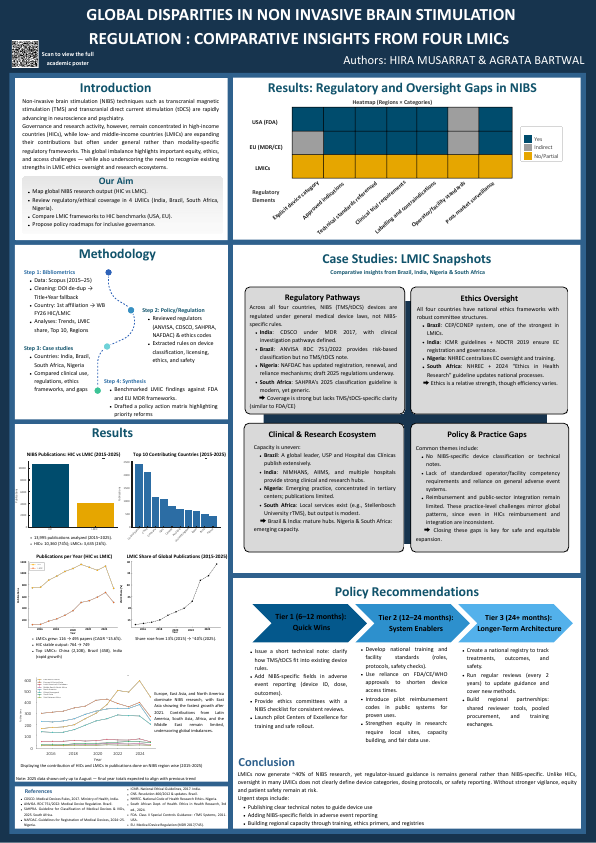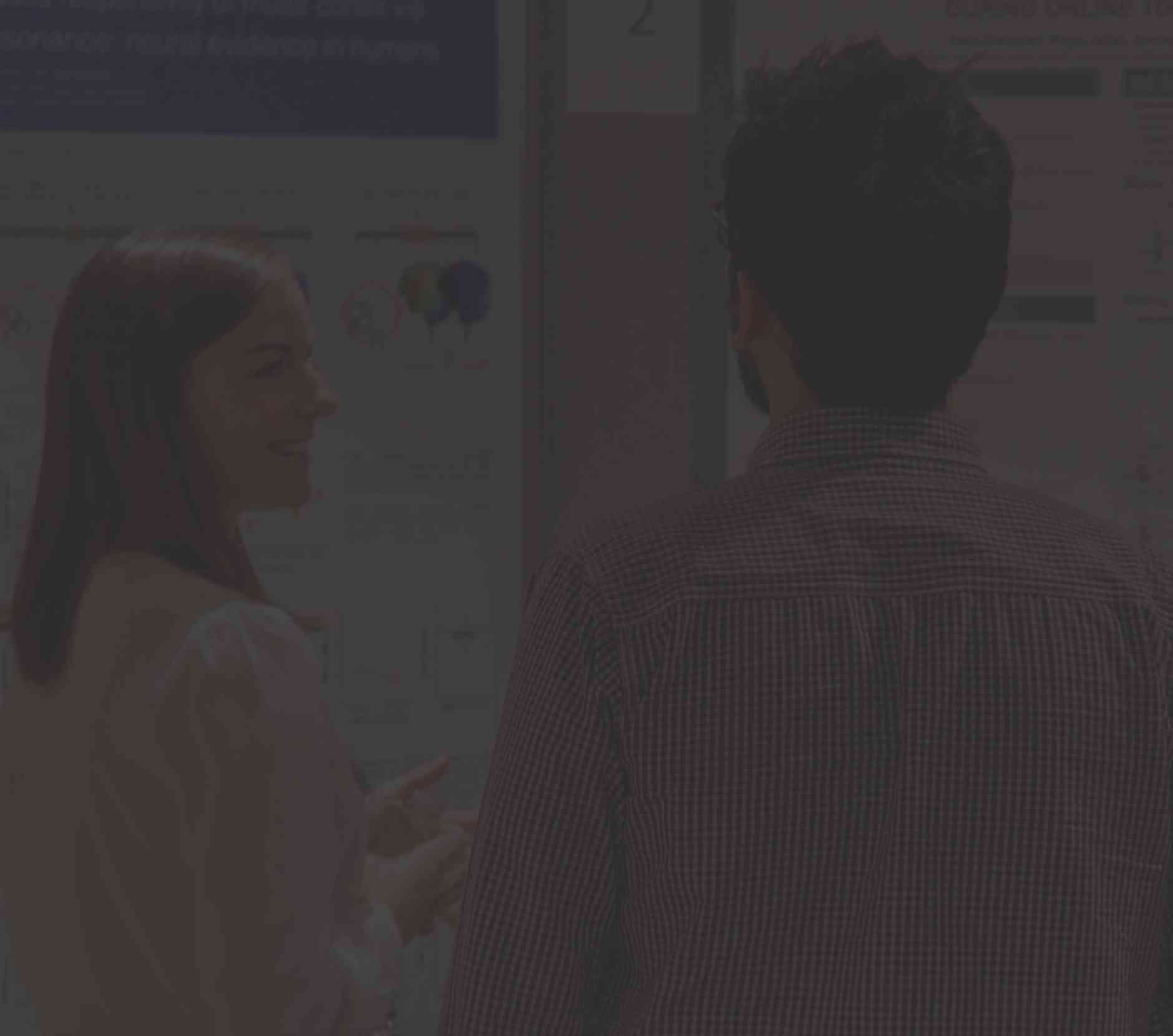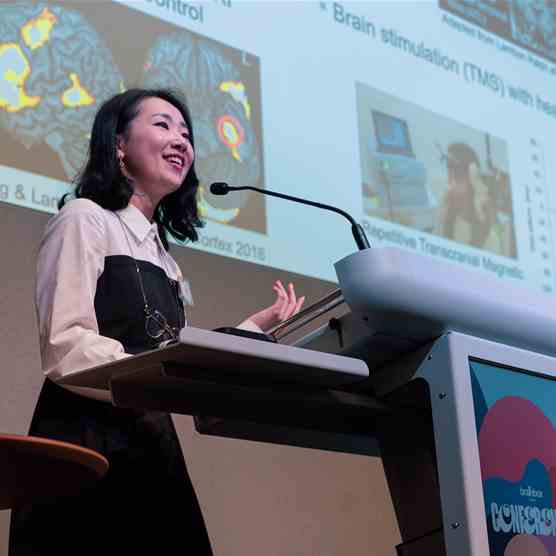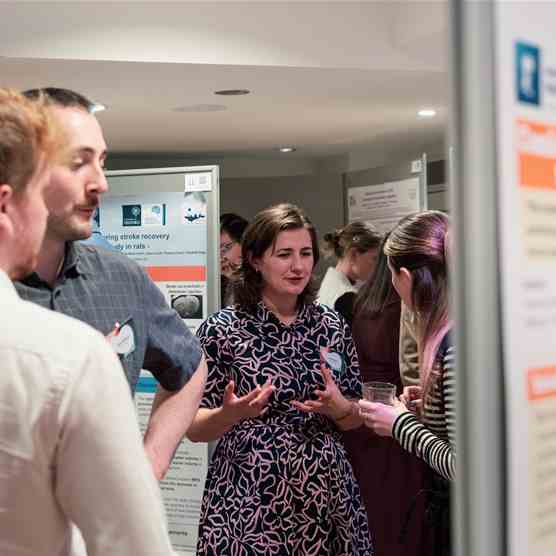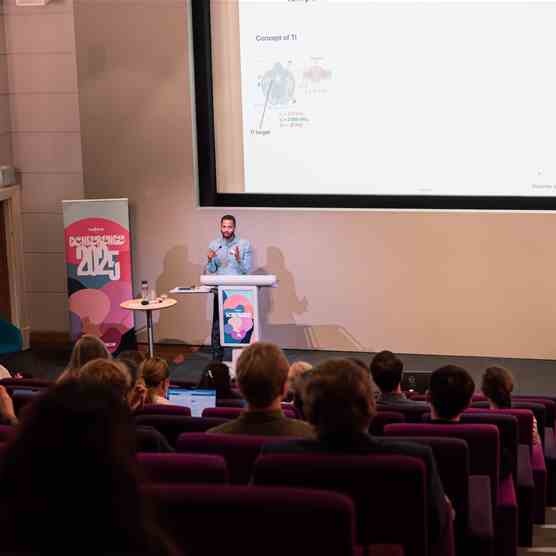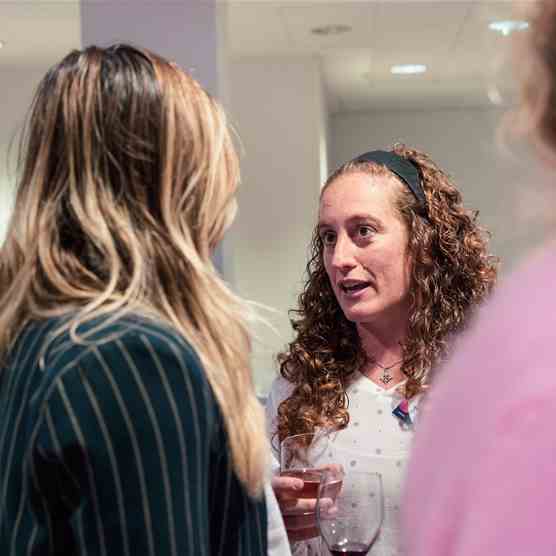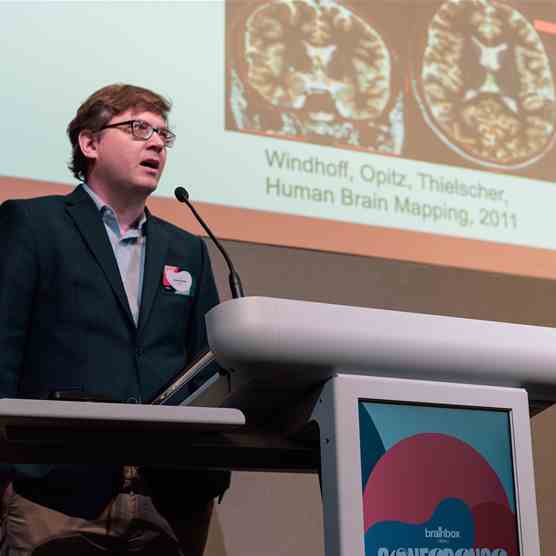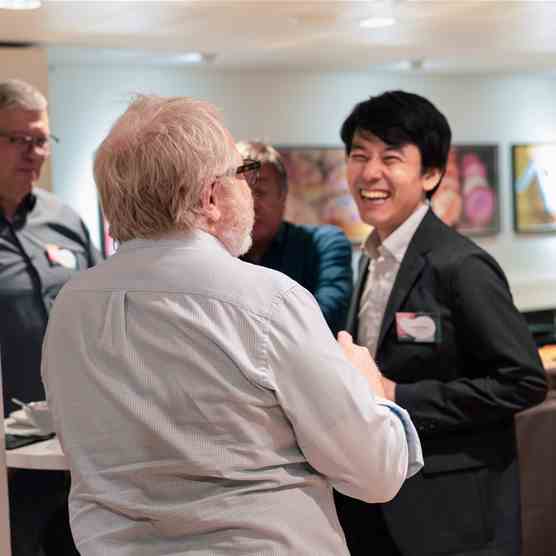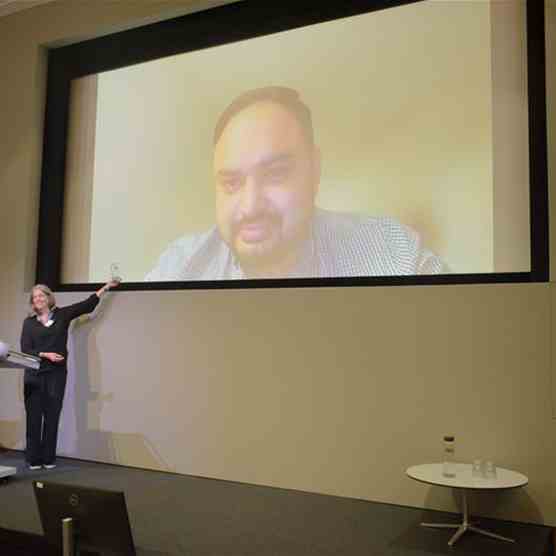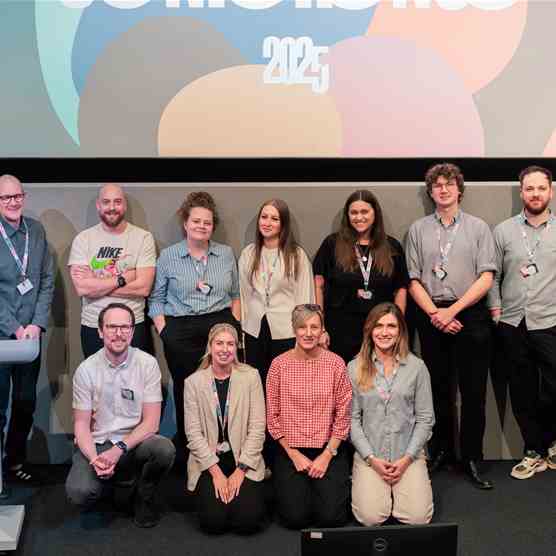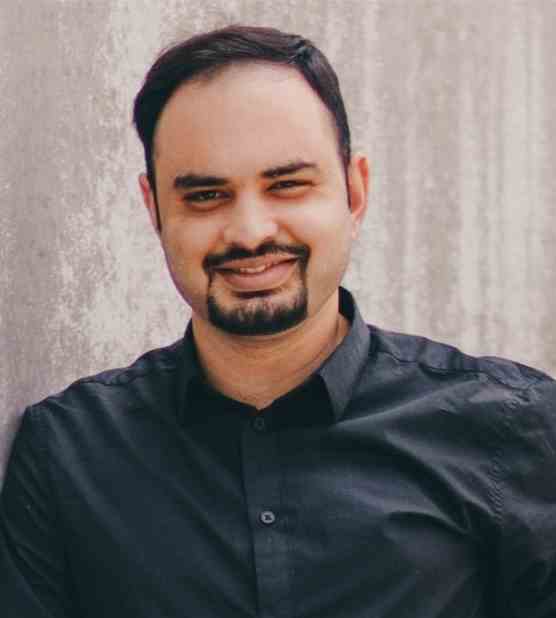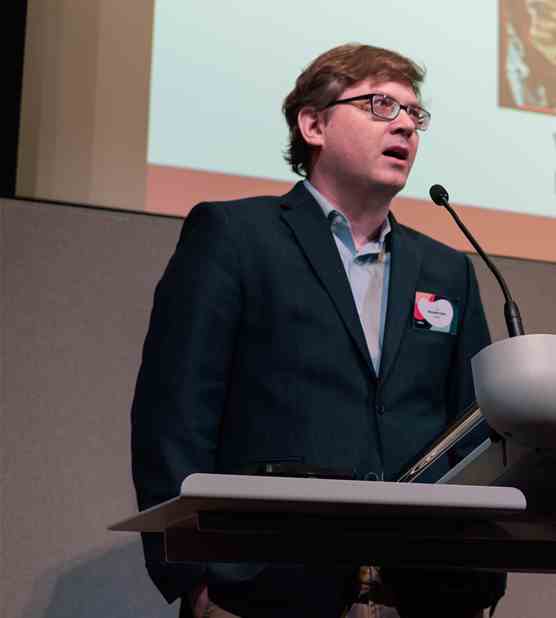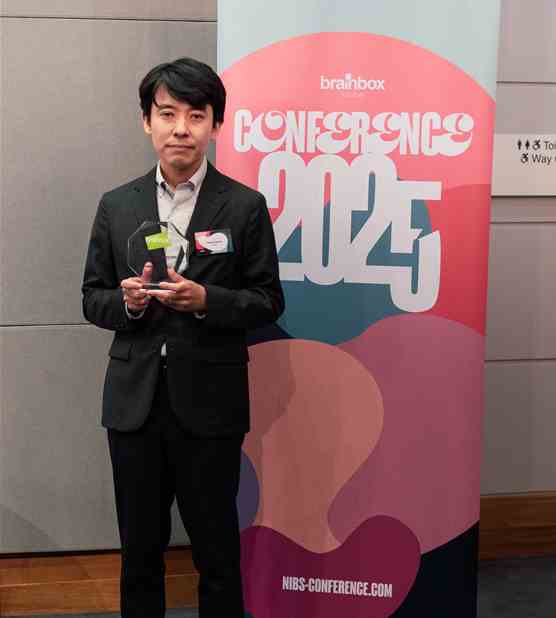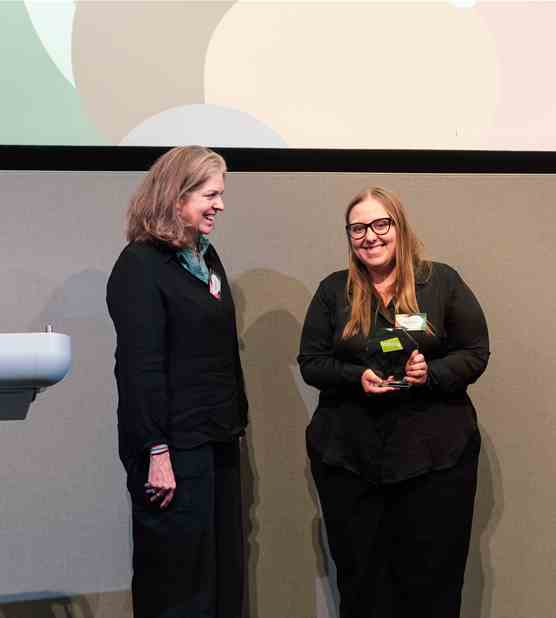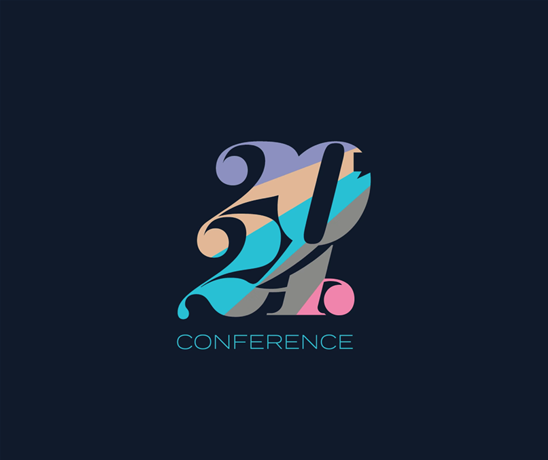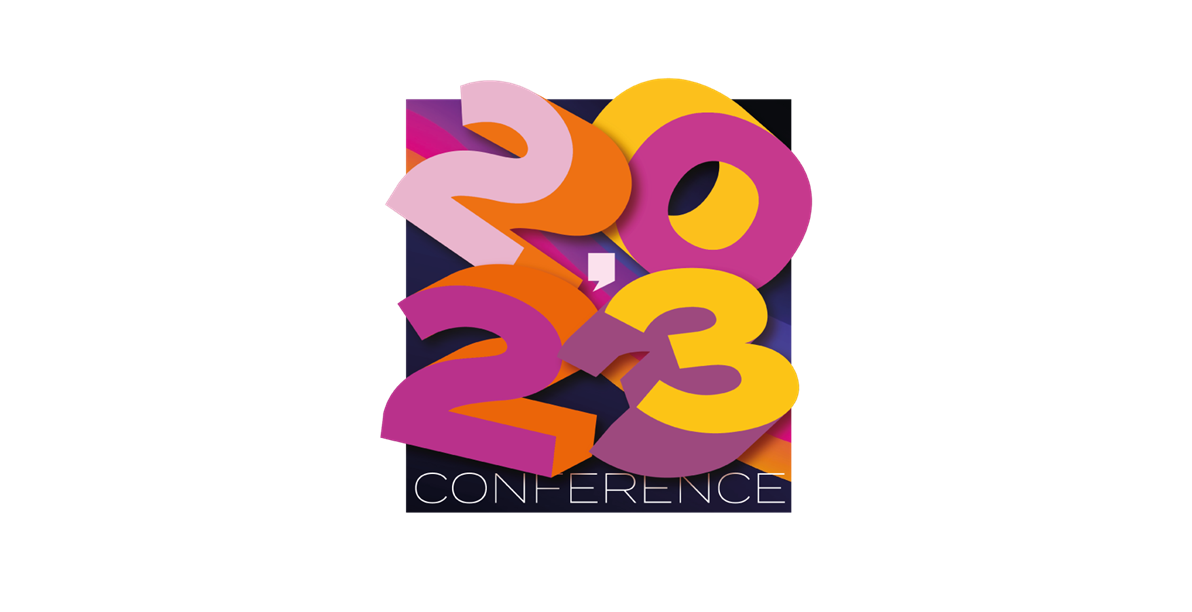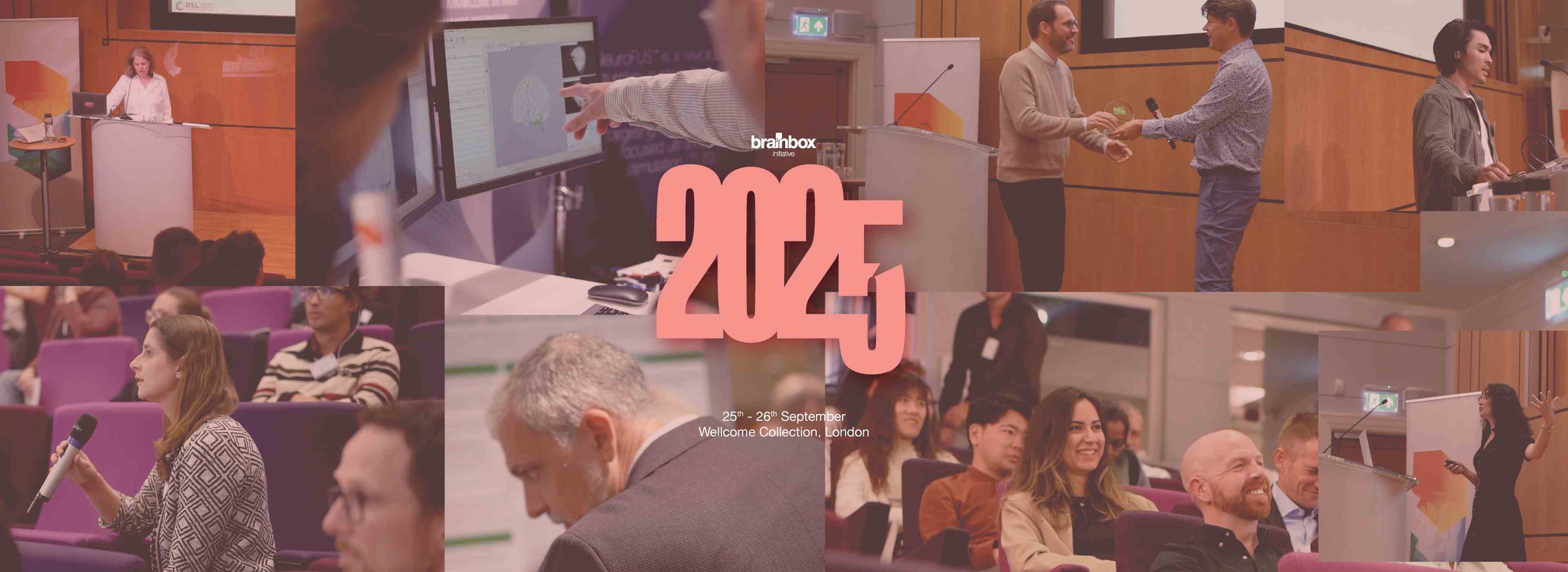

2025 Conference
25th-26th September, 2025
London, United Kingdom
About the Brainbox Initiative Conference
The Brainbox Initiative Conference is thrilled to announce its 9th annual event, dedicated to advancing research in non-invasive brain stimulation and neuroimaging. Taking place on 25th-26th September 2025 at the prestigious Wellcome Collection in London, this conference is a must-attend for early-mid career researchers.
Key Topics for 2025
Over two engaging days, the programme explored groundbreaking research in:
- Transcranial Magnetic Stimulation (TMS)
- Transcranial Electrical Stimulation (tES, tDCS, tACS, tRNS)
- Transcranial Focused Ultrasound Stimulation (TUS/tFUS)
- Neuroimaging and Methodologies
Since its inception in 2017, the conference has been a platform for early and mid-career researchers to present their work alongside world-renowned experts, fostering innovation and collaboration.
Our speakers

Jessica Andrew
Lancaster University
EEG
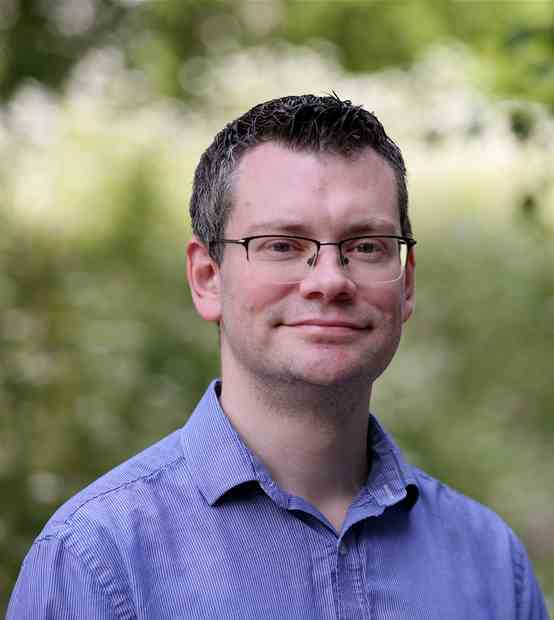
Dr Paul Briley
University of Nottingham
TMS, tACS
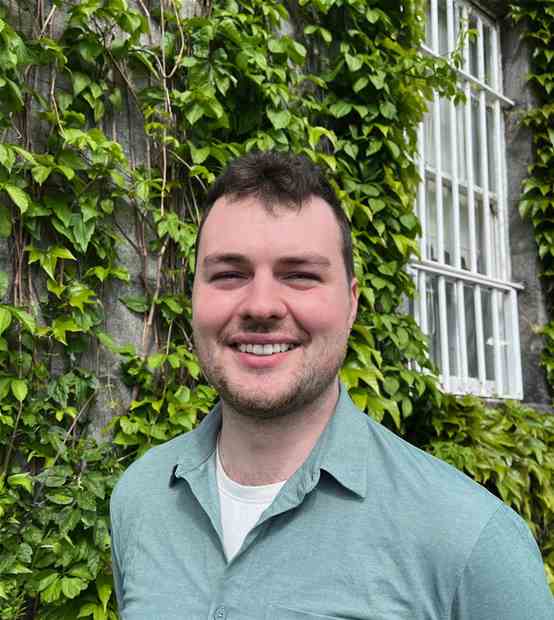
Dr Gabriel Byczynski
Geneva University Hospital
EEG

Dr Suraya Dunsford
University of Plymouth
TUS

Dr Katherine Dyke
University of Nottingham
NIBS with Imaging
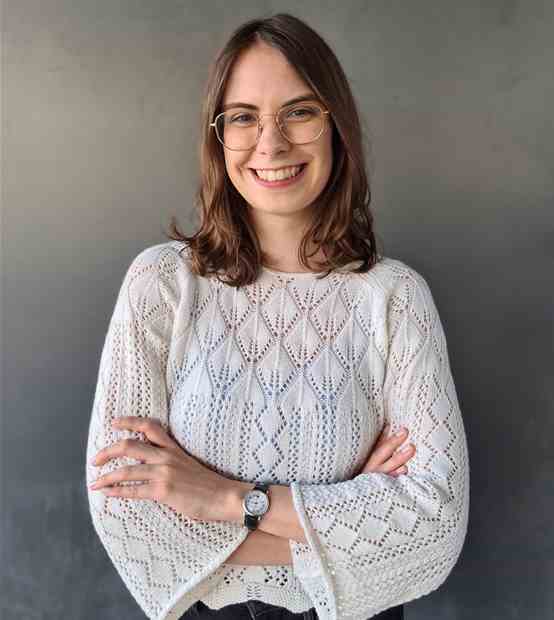
Anna Fromm
Greifswald University Hospital
tES
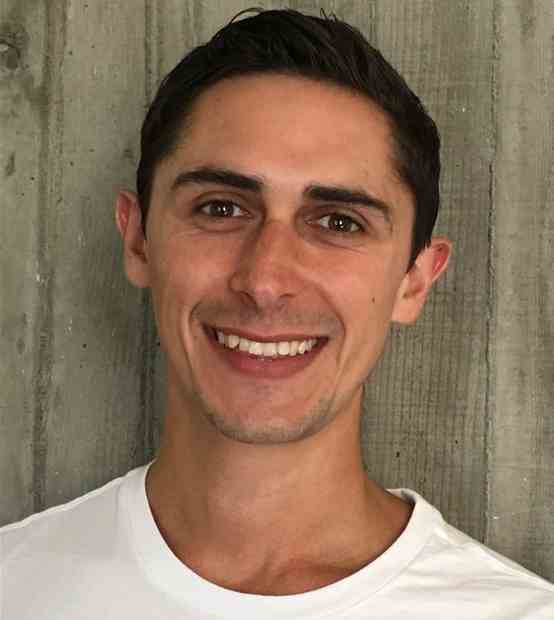
Dr Ricci Hannah
King's College London
TMS
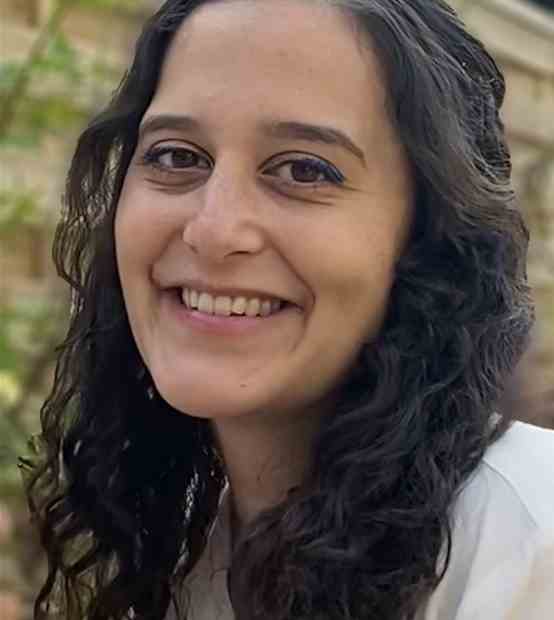
Dr Jade Jackson
University of Cambridge
TMS
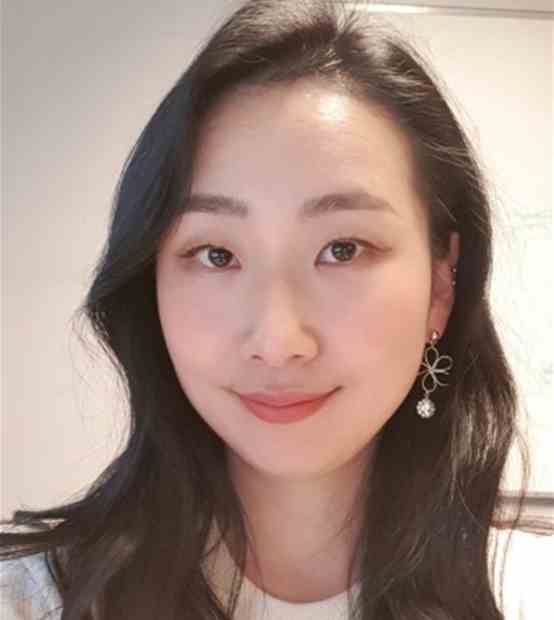
Dr JeYoung Jung
University of Nottingham
Multimodal Imaging with TMS/TUS
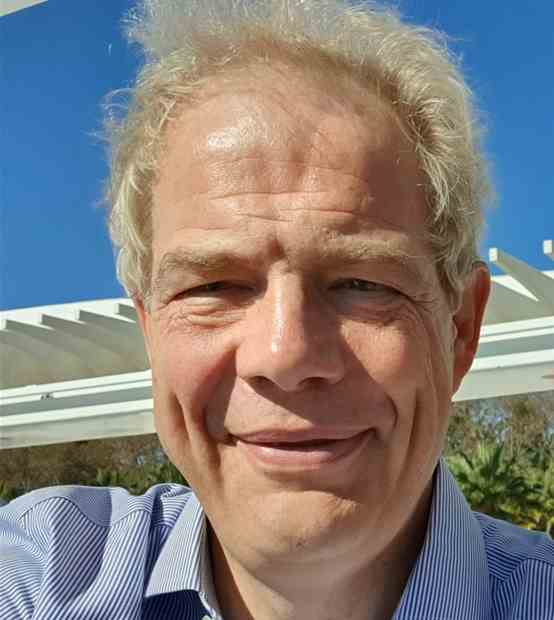
Professor Martin Koltzenburg
University College London
TMS

Dr Benjamin Kop
Stanford University
TUS
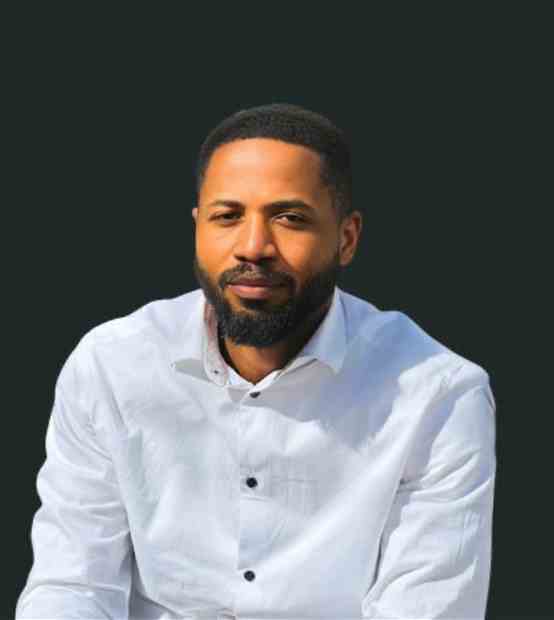
Prince Okyere
University of Surrey
TIS

Professor Alberto Pisoni
University of Milano-Bicocca
TMS-EEG, tDCS
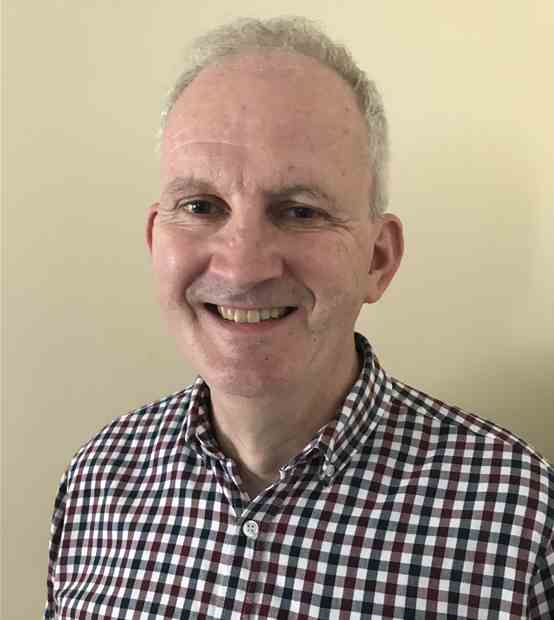
Michael Sanders
University of Oxford
Neuroimaging

Charlotte Smets
KU Leuven
TUS
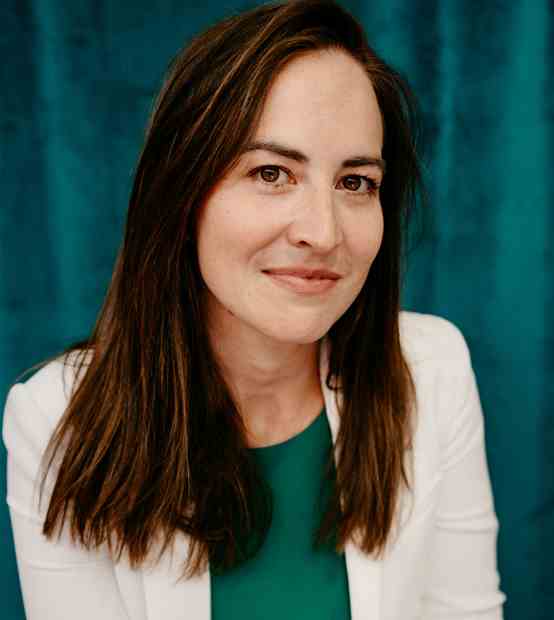
Professor Sara Tremblay
University of Quebec in Outaouais
rTMS
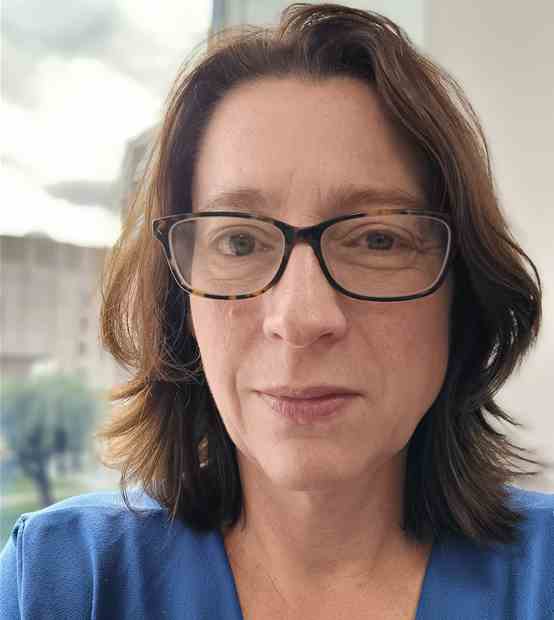
Dr Caroline Witton
Aston University
Magnetoencephalography

Jessica Andrew
Lancaster University
Jessica Andrew is a Ph.D. student in Cognitive Neuroscience at Lancaster University, supervised by Dr. Helen Nuttall, Dr. Christopher Gaffney, and Prof. Christopher Plack, also supported by a CASE studentship in partnership with Brainbox Initiative.
Her research investigates how repeated exposure to sub-concussive head impacts in contact sports affects auditory processing in the brain. Using EEG, she examines both subcortical and cortical auditory evoked potentials in athletes from contact and non-contact sports.
Her work aims to better understand the neural consequences of repetitive sub-concussive impacts, with the long-term goal of identifying early neural markers of head impact exposure and contributing to safer sporting practices.

Dr Paul Briley
University of Nottingham

Dr Gabriel Byczynski
Geneva University Hospital
Dr Byczynski is a Postdoctoral Research Fellow at the University of Geneva and Geneva University Hospitals, Switzerland, working on a phase II clinical trial investigating a pharmaceutical intervention for post-stroke recovery and learning.
His work involves varying forms of neuroimaging to measure the influence of CCR5 antagonism on motor recovery and plasticity, including microstructure/DWI, whole-brain MRS, and fMRI.
He received his PhD from Trinity College Dublin, Ireland, working under Prof. Sven Vanneste to study the effects of occipital nerve stimulation on motor learning, attention, and auditory perception with EEG, TMS, and physiological recording.
Dr Byczynski's research focus is understanding motor learning processes under normal and pathological conditions, and how brain imaging and stimulation can be used to quantify and alter these processes.

Dr Suraya Dunsford
University of Plymouth

Dr Katherine Dyke
University of Nottingham
Dr Katherine Dyke is an assistant professor in the School of Psychology at the University of Nottingham, which is also where she completed several post docs, and her PhD.
Dr Dyke’s research interests include combining non-invasive brain stimulation (tDCS, TMS, MNS) and neuro-imaging (MRS / fMRI) approaches to enhance our understanding of the brain in health and in specific conditions such as Tourette Syndrome.
A key focus of this work is exploring the reliability and biological underpinnings of different stimulation approaches to help evaluate their potential as methods for research and therapy.

Anna Fromm
Greifswald University Hospital
Anna is pursuing her PhD in Prof. Daria Antonenko's lab at the University of Greifswald, Germany. She has a Master’s in Psychology.
Her research focuses on the neurobiological aspects of brain plasticity and cognitive aging, specifically examining how transcranial direct current stimulation (tDCS) impacts these areas.
By utilizing multimodal MRI, Anna studies the impact of tDCS on structural and functional brain alterations during the learning process, with the goal of identifying indicators of individual response variability and the effectiveness of the stimulation.

Dr Ricci Hannah
King's College London

Dr Jade Jackson
University of Cambridge
Dr Jade Jackson is a research associate at the MRC Cognition and Brain Sciences Unit, University of Cambridge.
She uses multimodal neuroimaging and neurostimulation techniques, both stand-alone and concurrently, to study the human capacity for flexible cognition.
She develops and tests novel brain stimulation paradigms to:
- Investigate the selection, representation and exchange of task-relevant information in the brain
- Discern whether the information we read out from the brain with neuroimaging is meaningful for cognition and behaviour and
- Improve the practical application of concurrent neurostimulation and neuroimaging techniques.

Dr JeYoung Jung
University of Nottingham

Professor Martin Koltzenburg
University College London

Dr Benjamin Kop
Stanford University
Benjamin Kop is a postdoctoral researcher at Stanford University, working with Prof. Kim Butts Pauly on ultrasound neuromodulation of the visual system and MR-ARFI. He completed his master’s in Cognitive Neuroscience at UCL and obtained his PhD in human ultrasound neuromodulation under Dr. Lennart Verhagen. His doctoral research focused on the fundamental efficacy of transcranial ultrasound stimulation (TUS), methods development, and addressing peripheral confounds in brain stimulation.

Prince Okyere
University of Surrey
Prince Okyere is a Ph.D. student in the NeuroModulation (NeMo) lab at the University of Surrey, supervised by Dr. Ines Violante, Dr Valeria Jaramillo and Prof. Roi Cohen Kadosh.
His research investigates non-invasive deep brain stimulation of the hippocampus during sleep to understand memory consolidation mechanisms.
Prince uses Temporal Interference Stimulation (TIS) – a non-invasive brain stimulation technique capable of targeting deep brain structures like the hippocampus. He combines TIS with high-density EEG and behavioural measures to examine hippocampal-cortical dialogue during sleep.
His work aims to identify how brain activity during sleep supports long-term memory formation, with the long-term goal of developing neuromodulatory interventions for cognitive enhancement and therapeutic applications for memory-related disorders.

Professor Alberto Pisoni
University of Milano-Bicocca
Alberto Pisoni is an Associate Professor in Cognitive Neuroscience at the Department of Psychology, University of Milano Bicocca. His research group is specialized in the use of TMS-EEG co-registration to study the neurophysiological underpinnings of cognitive and motor functions. His work focuses on understanding how these processes influence cortical excitability, as well as effective and functional connectivity.
Recently, he has been leading several research projects using TMS-EEG as a tool to evaluate and monitor the effects of non-invasive brain stimulation, aiming to personalize and optimize stimulation parameters, particularly to improve the effectiveness and reproducibility of transcranial direct current stimulation (tDCS).

Michael Sanders
University of Oxford
Currently a Research Radiographer employed by the University of Oxford at OxCIN formerly FMRIB.
Michael Sanders has been a radiographer since 1987 working in a variety of roles within both the NHS and the private sector, with approximately 15 years of this being in neurological and neurovascular imaging, including preoperative planning, clinical trial and interventional case imaging.
He has been a site training specialist responsible for delivering medical imaging training across different imaging modalities for clinical trial sites, delivering training in Europe, the USA and South Africa.
Prior to this he was a clinical specialist in endovascular product support, providing technical training for clinicians and support staff, also responsible for Sales and Technical Staff training.
In addition to a radiographic qualification, he has an MSc in Functional Neuroimaging from Brunel University, London

Charlotte Smets
KU Leuven
Charlotte Smets is a PhD student in the Neuromodulation Research Lab of Prof. Myles Mc Laughlin at KU Leuven.
She holds a Master’s degree in Biomedical Sciences and was awarded a doctoral fellowship from the Research Foundation – Flanders (FWO) to support her PhD research on the use of low-intensity transcranial ultrasound stimulation (TUS) in rodent models.
Currently, she is investigating the effects of TUS on the somatosensory cortex of rats, with a particular focus on the variability and reliability of these effects.
By using in vivo electrophysiological recordings to assess neural responses, her work contributes to a deeper understanding of the potential and limitations of TUS as a non-invasive neuromodulation technique.

Professor Sara Tremblay
University of Quebec in Outaouais
Sara Tremblay earned her PhD in neuropsychology from the Université de Montréal in 2015. She completed postdoctoral training in neuromodulation at University College London under the mentorship of Prof. John Rothwell, and at the Centre for Addiction and Mental Health in Toronto with Dr. Jeff Daskalakis. Since July 2020, she has been a full-time professor of psychology at the Université du Québec en Outaouais, and an affiliated researcher at the University of Ottawa Institute of Mental Health Research since 2018.
Her research primarily leverages neuroimaging and neurophysiological methods to study the mechanisms underlying neuromodulation techniques, particularly rTMS. She examines how rTMS modulates brain activity using PET, resting-state fMRI and TMS-EEG, while also integrating innovative tools such as controllable TMS (cTMS) and robotic neuronavigation. She currently leads multiple clinical trials integrating these techniques to improve depression treatment. The overarching goal of her work is to optimize rTMS paradigms to develop more reliable and effective protocols for treating neurological and psychiatric disorders.

Dr Caroline Witton
Aston University
Submit a poster
Each year, the Brainbox Initiative Conference offers early-career researchers the opportunity not only to share their research posters at the conference, but also to supplement this display with a supporting three-minute, on-stage pitch to the full conference cohort. These pitches help researchers to ensure that they are reaching as wide an audience as possible at the event, as well as providing crucial first-hand experience of speaking on-stage at an internationally-attended event.
The call for entries is now closed. We will publish a list of the submitted posters shortly.
FAQs
How can I attend virtually?
For all attendees, registration will cover online access to the conference and all of the talks taking place. In-person attendees are also invited to join us for refreshments throughout the day, a food and drink reception, and entry to the poster hall.
Can I get a group discount?
If you are looking to register places for a group (Min. of three attendees), please get in touch with our team at info@brainbox-neuro.com and a member of our team will be able to help.
Will I receive a certificate of attendance for the Brainbox Initiative Conference?
We are happy to issue a Certificate of Attendance to attendees, poster presenters, and speakers of the conference. Please ensure that you request your certificate before January 1, 2026.
What times will the conference run? Can I view the programme?
We anticipate that the conference will run from 09:00-17:30 (GMT), with additional time on day one for a food and wine reception for poster presenters and attendees.
We are working hard to publish the programme as soon as possible.
I won't be able to travel to London, can I attend virtually?
The Brainbox Initiative Conference will be running as a hybrid event for 2025, allowing researchers the option to join us in person at the Wellcome Collection or via our virtual conference platform.
What else can I do at the Brainbox Initiative Conference?
As we will be hosting at the prestigious Wellcome Collection in the centre of London, we invite everyone attending in person to join us for an extended poster session following the first day of the conference as well as explore the historical city.
Will there be an evening reception?
There will be an evening reception at the end of the first conference day with drinks and small dishes that all in-person attendees are welcome to attend.
How can I present a poster at BBI2025?
The call for posters for the Brainbox Initiative Conference is currently open until August 1, 2025. Please use the form located on the conference page to submit your abstract and our Scientific Committee will review your submission.
How can I attend virtually?
For all attendees, registration will cover access to the conference and all of the talks taking place. In-person attendees are also invited to join us for refreshments throughout the day, a food and drink reception, and entry to the poster hall.
What subjects will the conference cover?
This year, the conference will focus on:
Transcranial magnetic stimulation (TMS) techniques;
Transcranial electrical stimulation (tES/tDCS/tACS/tRNS) techniques;
Transcranial-focused ultrasound stimulation;
Neuroimaging and methodologies
What is the Brainbox Initiative Conference?
The Brainbox Initiative Conference is an annual meeting that puts the work being carried out by early and mid-career researchers at the forefront. The conference focuses on brain stimulation techniques, including TMS, tES, TUS/tFUS and neuroimaging.
Award winners
2025 conference posters
Transcranial Magnetic Stimulation
Cortical Paired Associative Stimulation of the Right Inferior Frontal Cortex and Pre-Supplementary Motor Area Modulates Risk-Taking and Reveals Anxiety-Driven Impulsivity
Violeta Casero, Yifan Cui, Saurabh Sonkusare, Nathaniel Tung, Qiaoting Huang, Qiong Ding, Oliver Knight, Valerie Voon
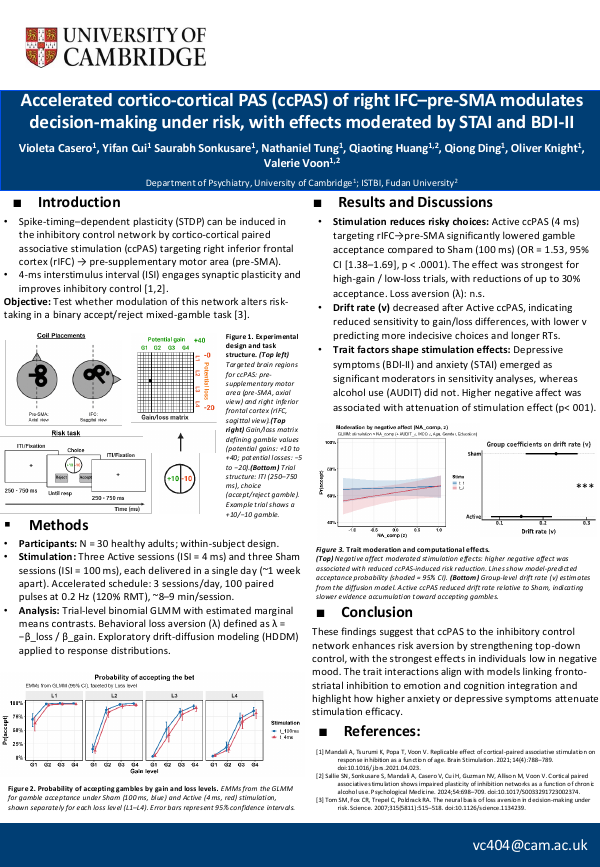
Using SimNIBS Electric-Field Variables to Predict Response to Theta Burst Stimulation Treatment in Males and Females with Treatment Resistant Depression
Emma Cummings, Aref Pariz, Rosalie Letourneau, Shaan Couture, Arthur R. Chaves, Sara Tremblay
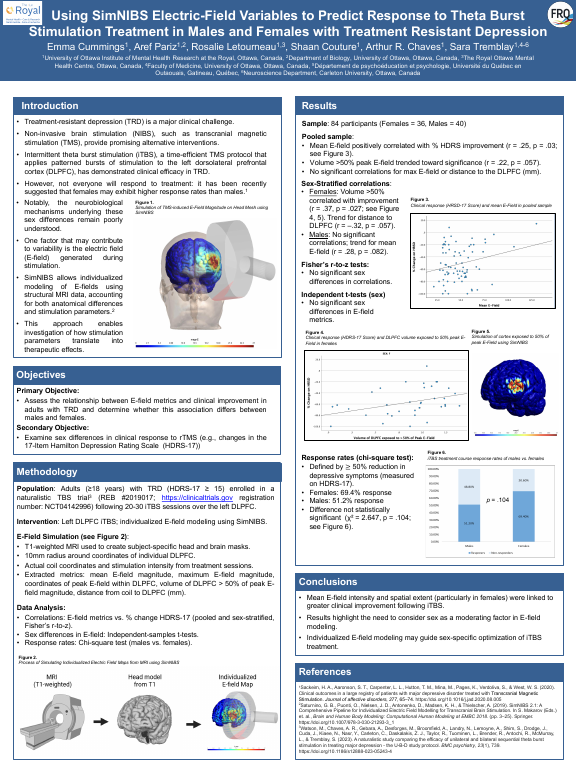
Monophasic and Biphasic iTBS Effects on Cognitive and Physiological Markers in Low Mood
Daniel Graham, Verena Sarrazin, Jacinta O’Shea

Transcranial Electrical Stimulation
Investigating the Thalamic Mechanisms of Visually Evoked Potentials through Temporal Interference Stimulation
Tobias Raufeisen, Prince Okyere, Valeria Jaramillio, Derk-Jan Dijk, Ines R. Violante, Ullrich Bartsch
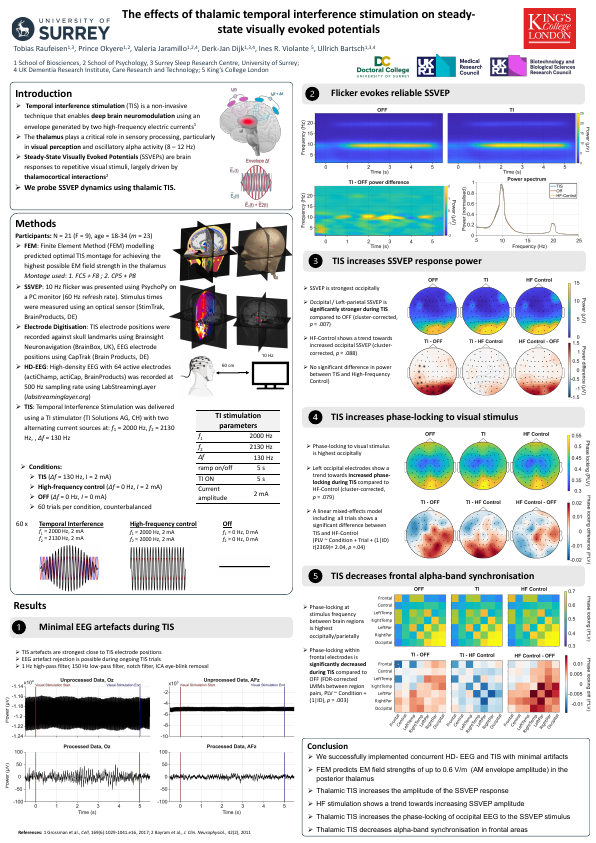
Home-based tDCS to Enhance Cognitive Control in Patients with Obesity Before Bariatric Surgery: A Preliminary Study
Holštajn Zemánková P, Kropáčová S, Lamoš M, Gajdoš M, Rektorová I
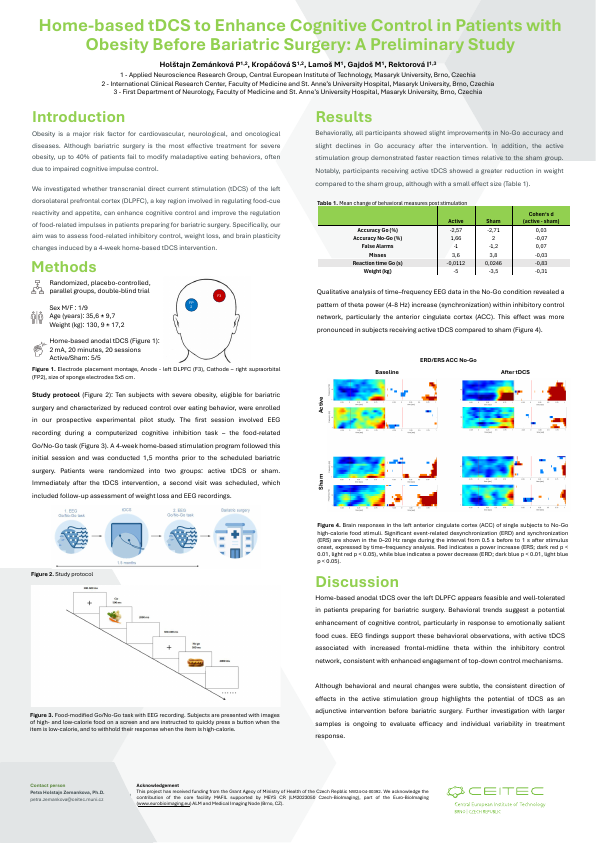
Effects of high-definition theta tACS on oscillatory brain activity and working memory
Lucy Webster, Jemima Shickle, Alexander Axford, Richard Morriss, Paul M Briley
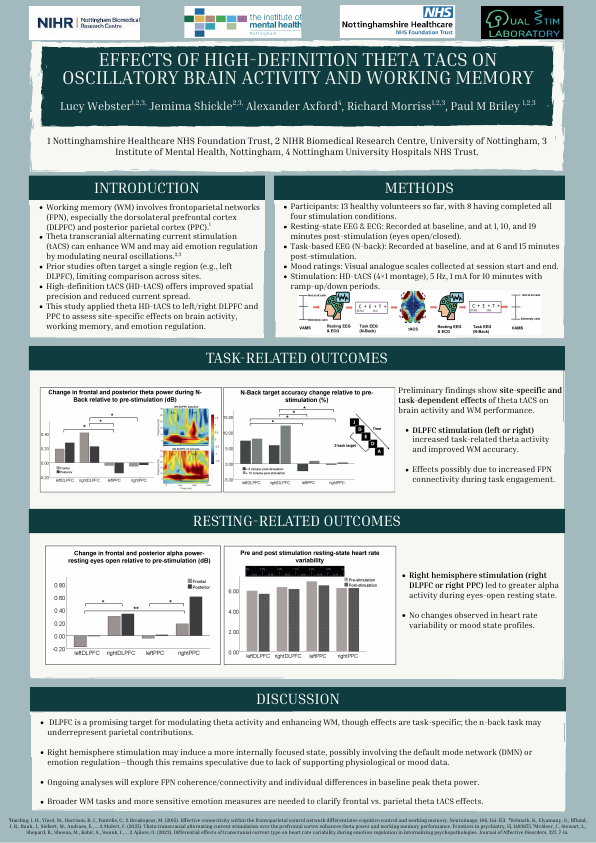
Multimodal personalization of tDCS for modulation of sensorimotor integration
Jan-Ole Radecke, Alexander Kuehn, Yvonne Buschermoehle, Andreas Sprenger, Till R. Schneider, Stefan Borgwardt, Joachim Gross, Carsten H. Wolters, Rebekka Lencer
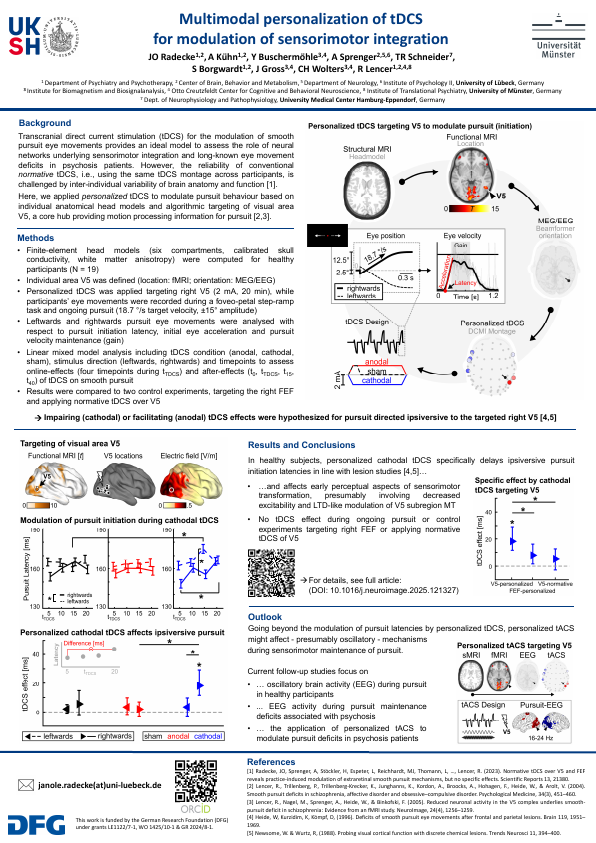
Theta-transcranial alternating current stimulation over the dorsolateral prefrontal cortex enhances visual working memory accuracy
Isabel Ellis, Katherine Dyke, JeYoung Jung, Nicholas Myers
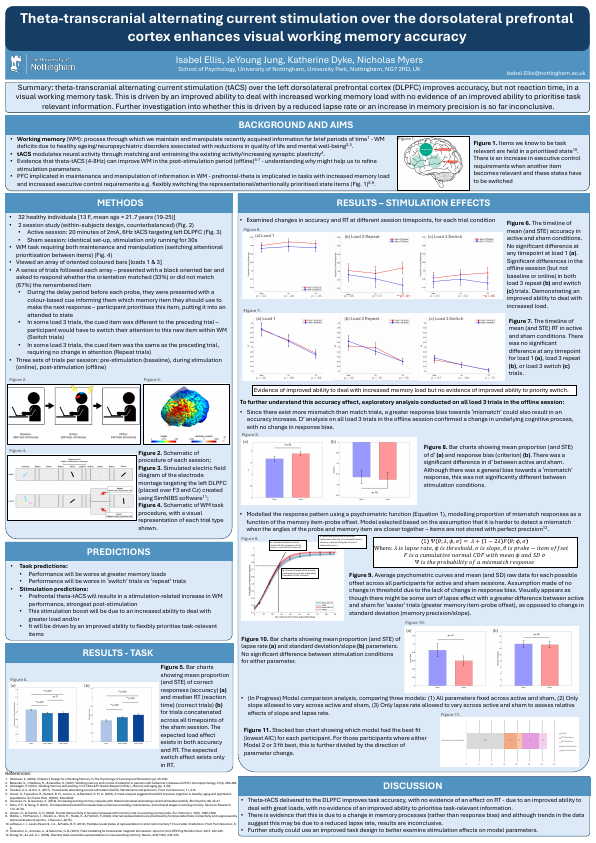
‘Flow’ transcranial direct current stimulation (tDCS) device and behaviour therapy training software used at home for community mental health team (CMHT) patients with symptoms of depression
Dr Chris Griffiths, William McIlhiney, Amy Evans, Dr Kate Walker, Andy Willis, Dr Alex O'Neill-Kerr
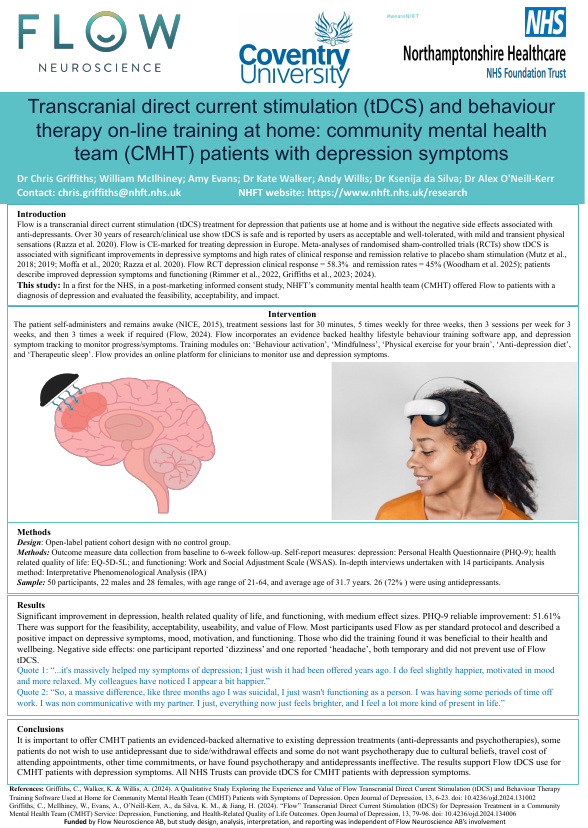
Combined tACS-TMS study: Effects of phase-dependent and frequency-selective M1 inhibition
Aneta Dvorakova, Aikaterini Gialopsou, Edward de Haan, Stephen R. Jackson
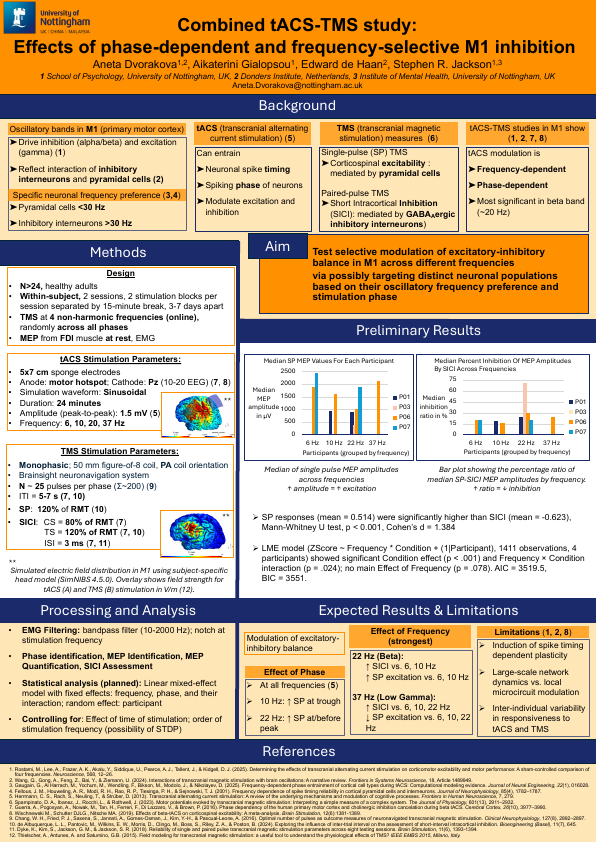
Focused Ultrasound Stimulation
FUS of Dentate Nucleus and Superior Cerebellar Peduncle with Similar Intensity Shows Distinct Outcomes on EEG
Mohammad AlKhawashki, Stefanos Kontogouris, Cyril Atkinson-Clement, Marilyn Gatica, Marcus Kaiser
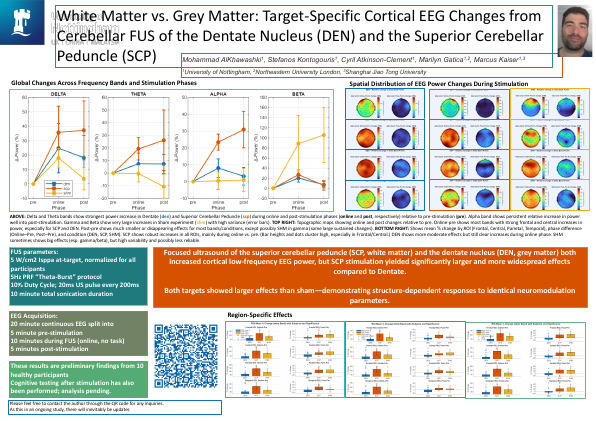
Transcranial Ultrasound Stimulation
Brief transcranial focused ultrasound stimulation causes lasting modifications to the synaptic circuitry of the rat hippocampus
William W. Watts, James K. Jiang, Robyn Cuthell, Jon Crompton, Daniel J. Whitcomb
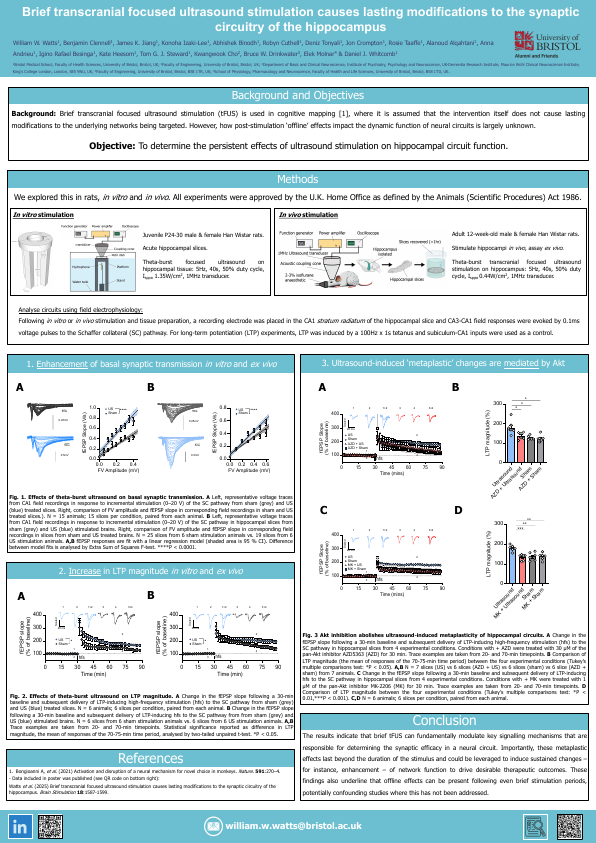
Mapping the sonication parameter space to characterise neuromodulation by ultrasound stimulation in the hippocampus
R. CUTHELL, W. W. WATTS, J. K. JIANG, J. A. CROMPTON, D. J. WHITCOMB
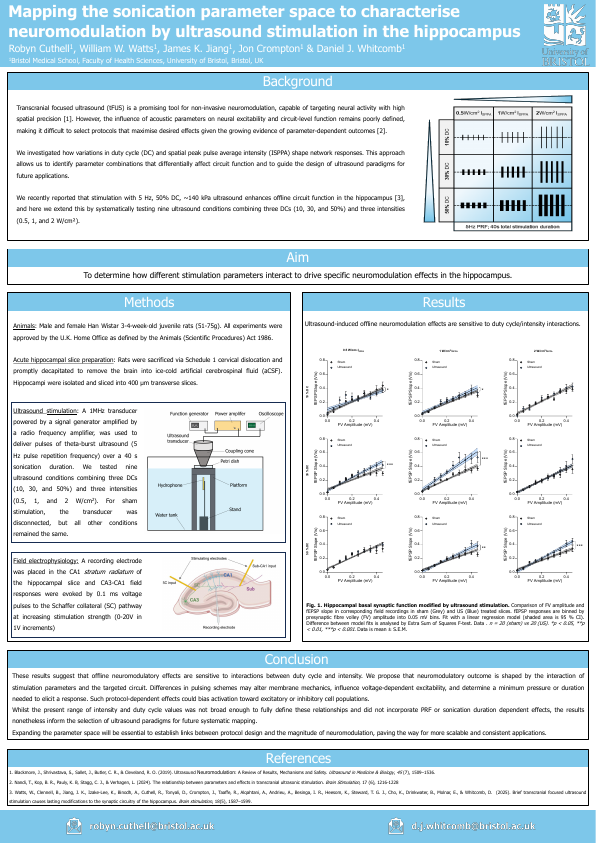
Ultrasound neuromodulation reveals distinct roles of the dorsal anterior cingulate cortex and anterior insula in Pavlovian biases
Nomiki Koutsoumpari, Johannes Algermissen, Siti Yaakub, Hanneke E. M. den Ouden, Nadege Bault, Elsa Fouragnan
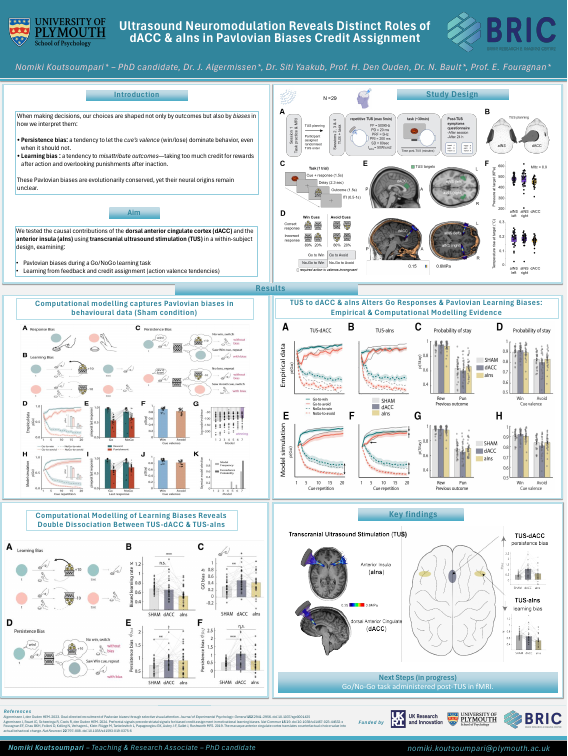
Ultrasound Meets Memory: A proposal for a new approach to study TUS-Induced neuroplasticity
Jie Liu, Myles Mc Laughlin
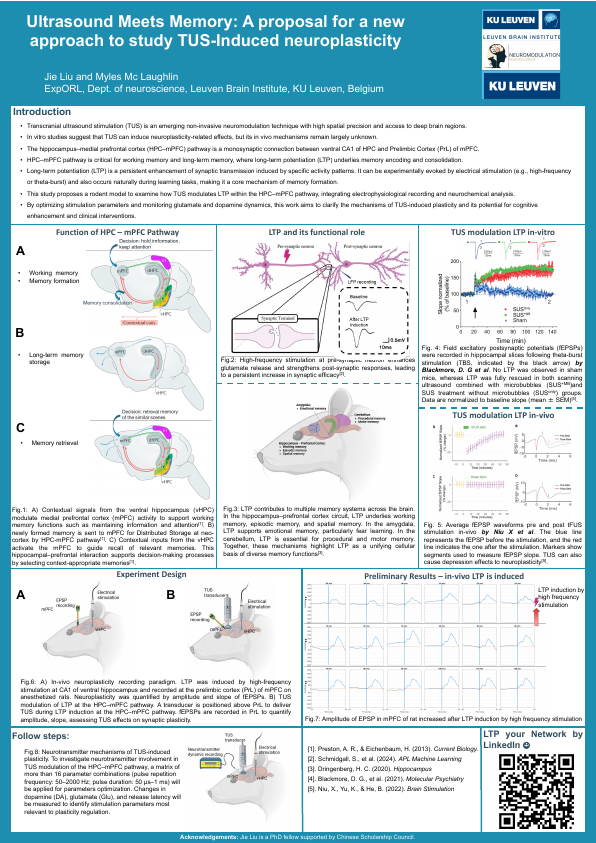
Transcranial Focused Ultrasound Modulates Motor Cortex Electrophysiological Activity in Rats
Haorun Huang, Charlotte Smets, Liyi Chen, Myles Mc Laughlin
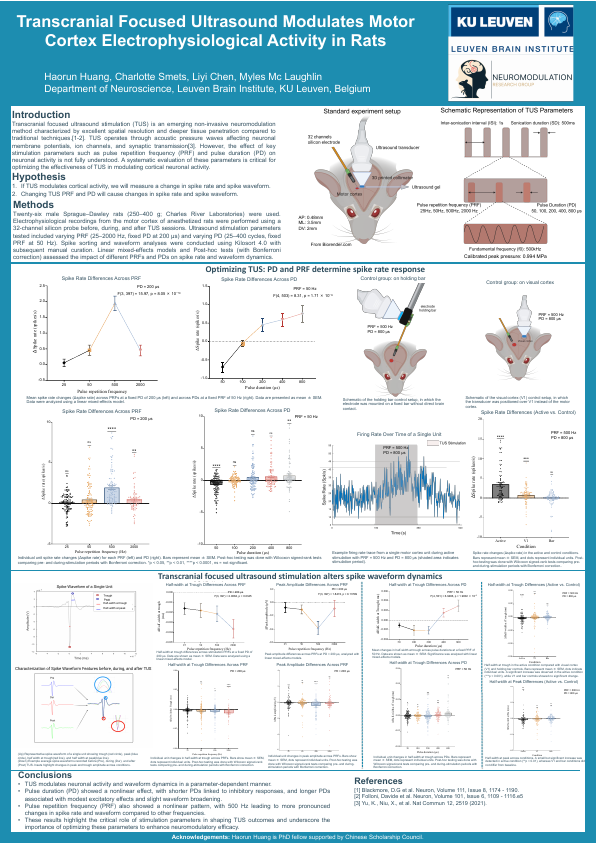
Modulating motivation and reinforcement learning: A protocol for repeated transcranial ultrasound stimulation of the nucleus accumbens
Dorothy Zhao, Mayra Albayrak, Alex Green, Laurel Morris.
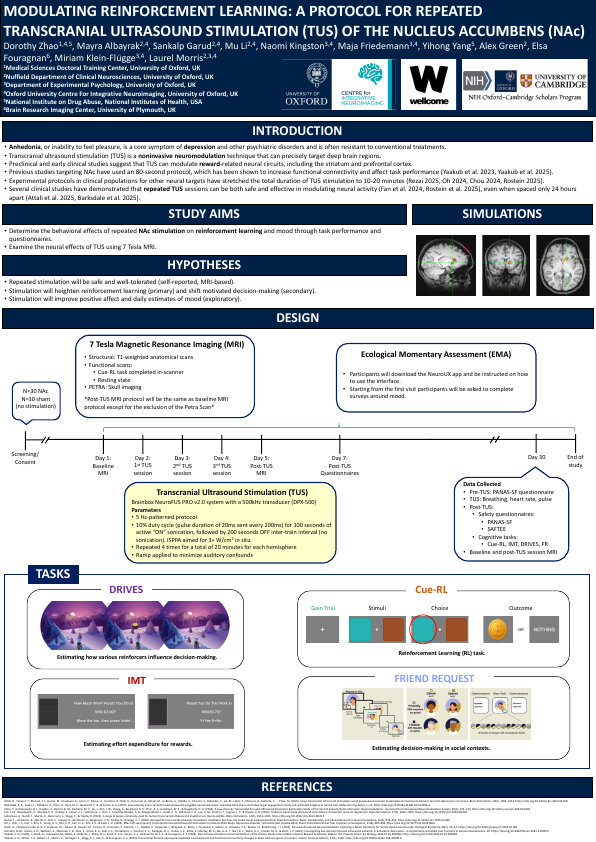
Neuroimaging
The Role of Microglia in Neuro-inflammation and Early Neurodegenerative Disease
Srijanita Maurya, Meghana Obarasu
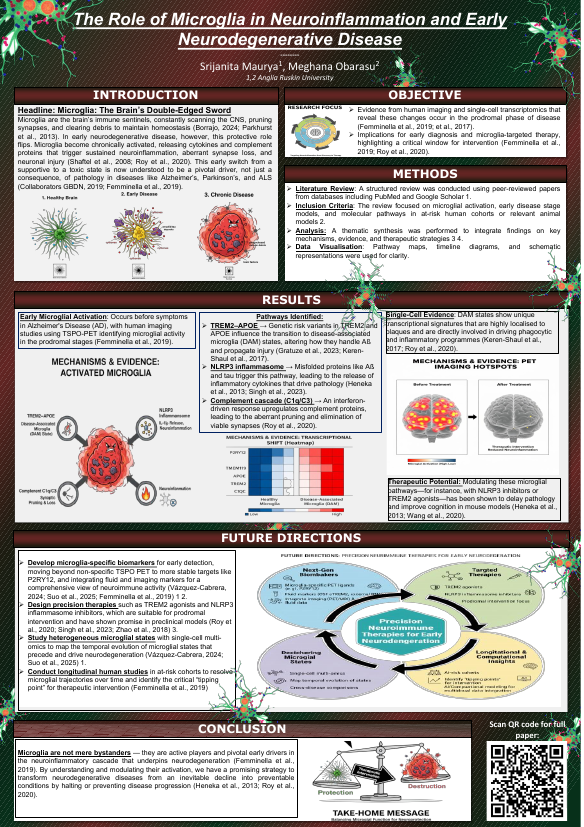
Spatial Reorganization of fMRI Functional Networks Encodes Task- and Participant-specific features
Guthrie SE, Farahibozorg S-R, Woolrich MW
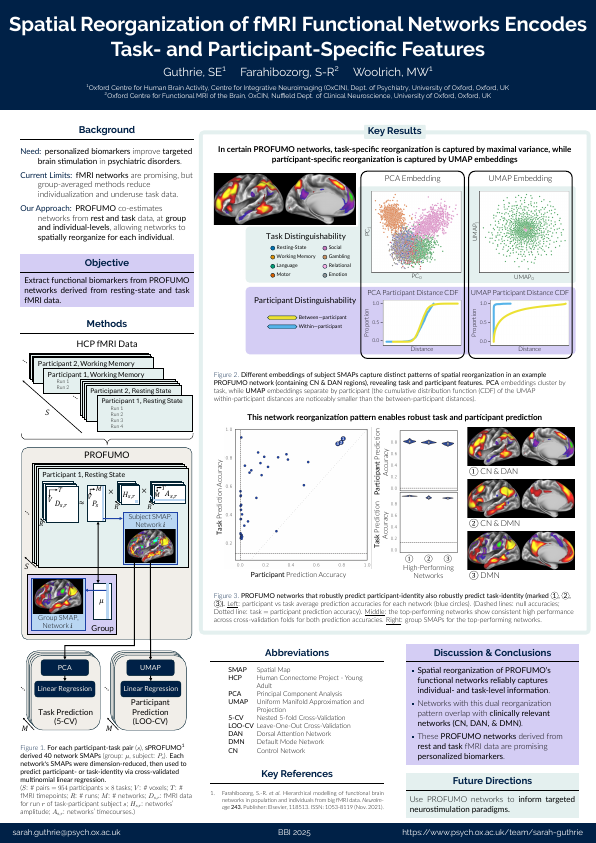
Lateralized, sex specific habenular modulation of substantia nigra and ventral tegmental resting connectivity in healthy adults
Surroca López A, Medina Osuna F, De la Peña Arteaga V, Chavarría Elizondo P, Martínez Zalacaín I, Juaneda Seguí A, Saiz Masvidal C, Fullana MA, Soriano Mas C,
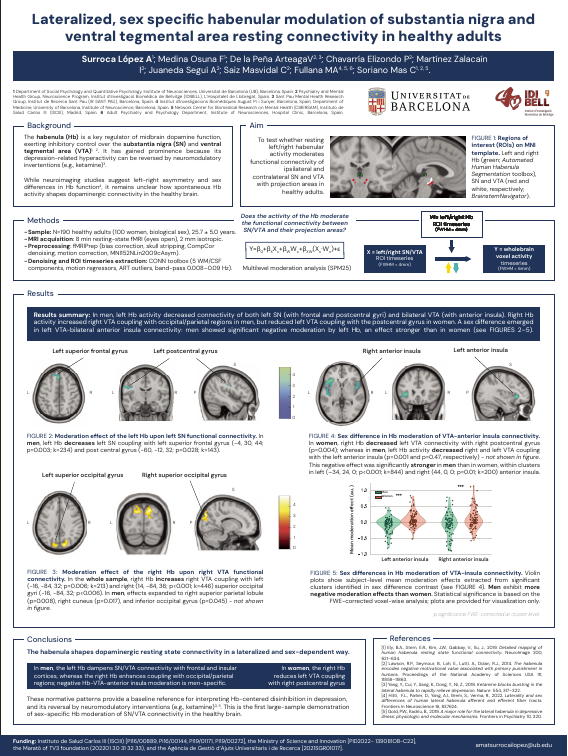
Non-Invasive Brain Stimulation
Predictors of the Effectiveness of Non-Invasive Brain Stimulation in Parkinson’s Disease and Alzheimer’s Disease: A Systematic Review
Andrea Lepiesova, Lubos Brabenec
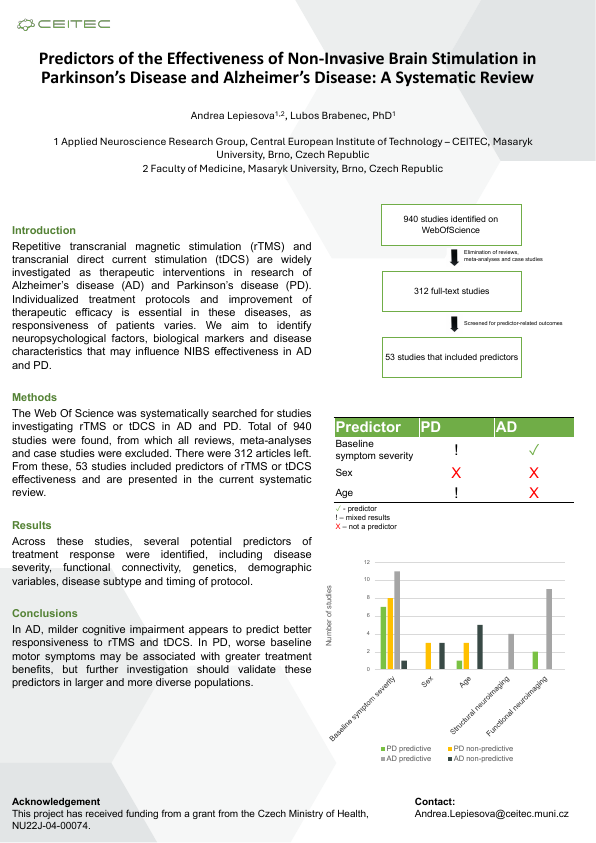
Combining NIBS techniques: Is two better than one?
Jemima Shickle, Alexander Axford, Sue Fen Tan, Lucy Webster, Richard Morriss, Paul M Briley
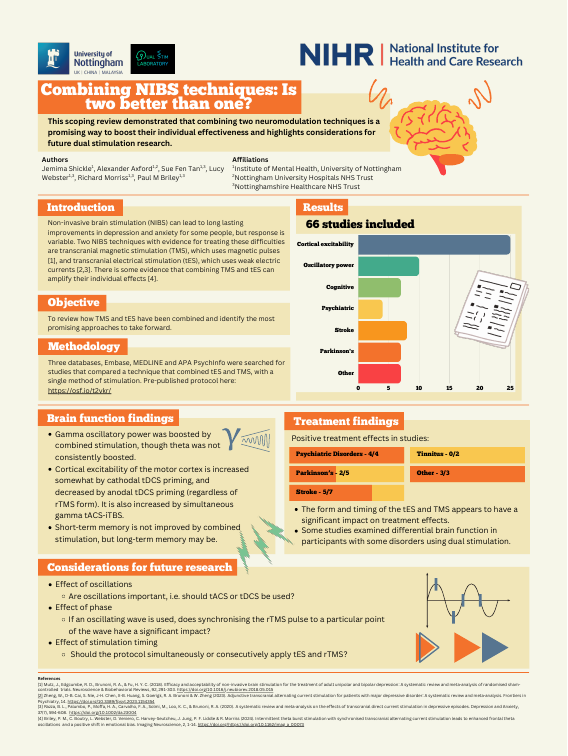
Global Disparities in Brain Stimulation Research: A Regulatory Neglect of the Global South
Hira Musarrat, Agrata Bartwal
